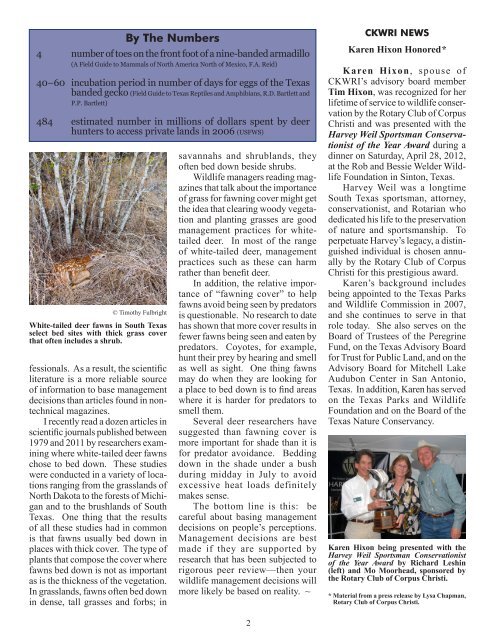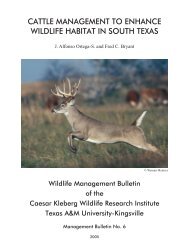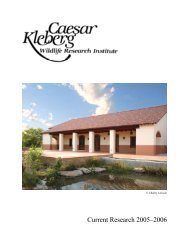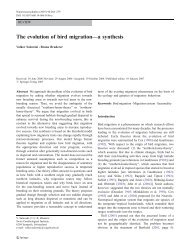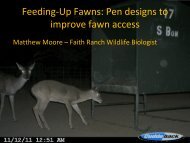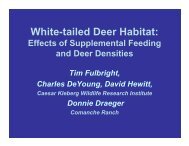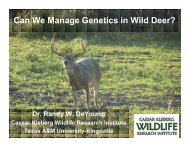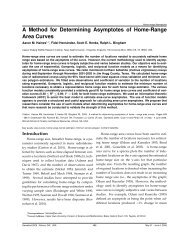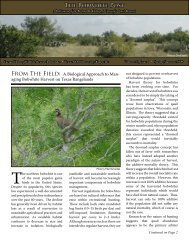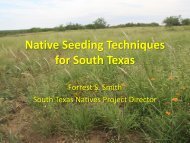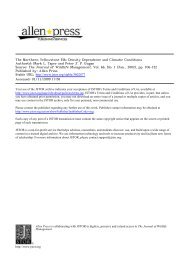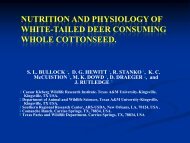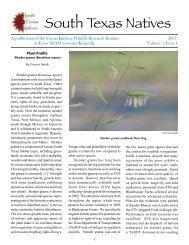south texas wildlife - Caesar Kleberg Wildlife Research Institute ...
south texas wildlife - Caesar Kleberg Wildlife Research Institute ...
south texas wildlife - Caesar Kleberg Wildlife Research Institute ...
You also want an ePaper? Increase the reach of your titles
YUMPU automatically turns print PDFs into web optimized ePapers that Google loves.
By The Numbers<br />
4 number of toes on the front foot of a nine-banded armadillo<br />
(A Field Guide to Mammals of North America North of Mexico, F.A. Reid)<br />
40–60 incubation period in number of days for eggs of the Texas<br />
banded gecko (Field Guide to Texas Reptiles and Amphibians, R.D. Bartlett and<br />
P.P. Bartlett)<br />
484 estimated number in millions of dollars spent by deer<br />
hunters to access private lands in 2006 (USFWS)<br />
© Timothy Fulbright<br />
White-tailed deer fawns in South Texas<br />
select bed sites with thick grass cover<br />
that often includes a shrub.<br />
fessionals. As a result, the scientific<br />
literature is a more reliable source<br />
of information to base management<br />
decisions than articles found in nontechnical<br />
magazines.<br />
I recently read a dozen articles in<br />
scientific journals published between<br />
1979 and 2011 by researchers examining<br />
where white-tailed deer fawns<br />
chose to bed down. These studies<br />
were conducted in a variety of locations<br />
ranging from the grasslands of<br />
North Dakota to the forests of Michigan<br />
and to the brushlands of South<br />
Texas. One thing that the results<br />
of all these studies had in common<br />
is that fawns usually bed down in<br />
places with thick cover. The type of<br />
plants that compose the cover where<br />
fawns bed down is not as important<br />
as is the thickness of the vegetation.<br />
In grasslands, fawns often bed down<br />
in dense, tall grasses and forbs; in<br />
savannahs and shrublands, they<br />
often bed down beside shrubs.<br />
<strong>Wildlife</strong> managers reading magazines<br />
that talk about the importance<br />
of grass for fawning cover might get<br />
the idea that clearing woody vegetation<br />
and planting grasses are good<br />
management practices for whitetailed<br />
deer. In most of the range<br />
of white-tailed deer, management<br />
practices such as these can harm<br />
rather than benefit deer.<br />
In addition, the relative importance<br />
of “fawning cover” to help<br />
fawns avoid being seen by predators<br />
is questionable. No research to date<br />
has shown that more cover results in<br />
fewer fawns being seen and eaten by<br />
predators. Coyotes, for example,<br />
hunt their prey by hearing and smell<br />
as well as sight. One thing fawns<br />
may do when they are looking for<br />
a place to bed down is to find areas<br />
where it is harder for predators to<br />
smell them.<br />
Several deer researchers have<br />
suggested than fawning cover is<br />
more important for shade than it is<br />
for predator avoidance. Bedding<br />
down in the shade under a bush<br />
during midday in July to avoid<br />
excessive heat loads definitely<br />
makes sense.<br />
The bottom line is this: be<br />
careful about basing management<br />
decisions on people’s perceptions.<br />
Management decisions are best<br />
made if they are supported by<br />
research that has been subjected to<br />
rigorous peer review—then your<br />
<strong>wildlife</strong> management decisions will<br />
more likely be based on reality. ~<br />
CKWRI NEWS<br />
Karen Hixon Honored*<br />
Karen Hixon, spouse of<br />
CKWRI’s advisory board member<br />
Tim Hixon, was recognized for her<br />
lifetime of service to <strong>wildlife</strong> conservation<br />
by the Rotary Club of Corpus<br />
Christi and was presented with the<br />
Harvey Weil Sportsman Conservationist<br />
of the Year Award during a<br />
dinner on Saturday, April 28, 2012,<br />
at the Rob and Bessie Welder <strong>Wildlife</strong><br />
Foundation in Sinton, Texas.<br />
Harvey Weil was a longtime<br />
South Texas sportsman, attorney,<br />
conservationist, and Rotarian who<br />
dedicated his life to the preservation<br />
of nature and sportsmanship. To<br />
perpetuate Harvey’s legacy, a distinguished<br />
individual is chosen annually<br />
by the Rotary Club of Corpus<br />
Christi for this prestigious award.<br />
Karen’s background includes<br />
being appointed to the Texas Parks<br />
and <strong>Wildlife</strong> Commission in 2007,<br />
and she continues to serve in that<br />
role today. She also serves on the<br />
Board of Trustees of the Peregrine<br />
Fund, on the Texas Advisory Board<br />
for Trust for Public Land, and on the<br />
Advisory Board for Mitchell Lake<br />
Audubon Center in San Antonio,<br />
Texas. In addition, Karen has served<br />
on the Texas Parks and <strong>Wildlife</strong><br />
Foundation and on the Board of the<br />
Texas Nature Conservancy.<br />
Karen Hixon being presented with the<br />
Harvey Weil Sportsman Conservationist<br />
of the Year Award by Richard Leshin<br />
(left) and Mo Moorhead, sponsored by<br />
the Rotary Club of Corpus Christi.<br />
* Material from a press release by Lysa Chapman,<br />
Rotary Club of Corpus Christi.<br />
2


